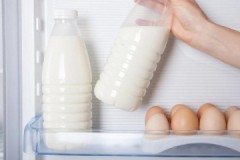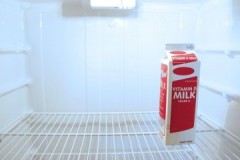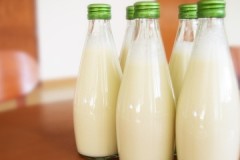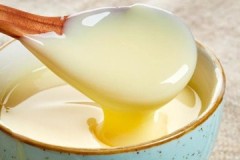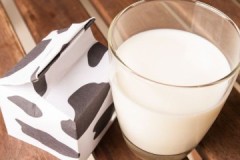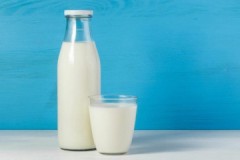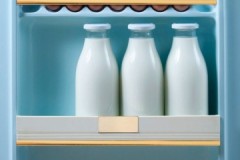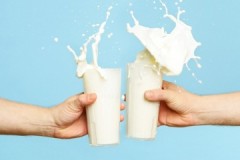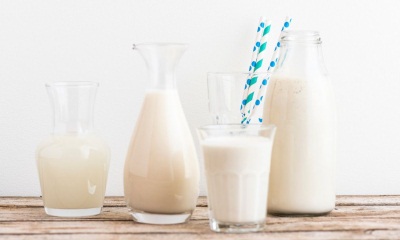 Milk is recognized as a perishable product, so certain rules must be followed when storing it.
Milk is recognized as a perishable product, so certain rules must be followed when storing it.
In addition, various factors influence the freshness of a product. Each type of milk also has its own storage characteristics.
Let's look at all the nuances of storing milk in more detail.
Content
General storage rules
In order for milk to benefit the body, it must be stored properly. The shelf life of a drink depends on many indicators.
 Among them:
Among them:
- type of milk;
- hygienic conditions;
- processing technology;
- ambient temperature;
- packaging and its tightness;
- specific manufacturer.
Each of the factors can increase or decrease the shelf life of milk.
Conditions
Milk is able to retain its properties in different conditions. The product can be kept in the refrigerator, freezer or at room conditions. In addition, milk “loves” dark places, without an abundance of sunlight. If suddenly the refrigerator breaks down, then the cow drink is placed in pantries, closets, cellars and other dark, cool rooms.
Temperature
One of the decisive factors when wanting to enjoy fresh milk. For the most part, the rate of deterioration of the product depends on the ambient temperature.Most often, milk requires storage at low temperatures above zero. Some varieties can withstand higher temperatures.
Details - in this article.
GOST
State standard 31450–2013 Drinking milk. Technical conditions. The document states that pasteurized, melted, ultra-pasteurized drinking milk without aseptic filling is stored at a temperature of +2 to +4 degrees. The drink, sterilized and ultra-pasteurized with aseptic filling, is stored at a temperature from +2 to +25 degrees.
Before setting the expiration date of a product, the manufacturer needs to approve the recipe, technology and other aspects in Rospotrebnadzor. That is why the same milk drink from different manufacturers has different expiration dates. All the nuances of production are not disclosed to ordinary buyers.
How to store and for how long?
Milk should be stored in a tightly closed container, away from strong-smelling foods. The shelf life of the product is very wide, due to the variety of processing methods. Storage periods can vary from 2 hours to 6 months, maximum of a year. The longer the shelf life of milk, the higher the risk that it contains artificial additives and fewer nutrients.
In a refrigerator
 The ideal option for storing milk is the refrigerator. There, the drink is able to remain fresh throughout the shelf life specified by the manufacturer.
The ideal option for storing milk is the refrigerator. There, the drink is able to remain fresh throughout the shelf life specified by the manufacturer.
It is better to choose a place for milk away from the door so that the temperature difference does not affect the quality of the product.
Glass and ceramic containers with a tight lid are considered suitable containers for milk. However It is undesirable to overfill an industrial product, since bottling takes place under hygienic conditions. Read more in this And this articles.
At room conditions
For some time, milk may not spoil even at room temperature. The safety of the product will depend on the type of drink, packaging and specific room temperature. There is only one rule here: the hotter the room, the higher the risk of product spoilage. It is best to put the milk in the coldest place.
In the freezer
If you are planning a sudden departure and there is milk left in the refrigerator, you can freeze the product. This method will allow you to preserve the drink for up to 6 months., but best consumed within 4-6 weeks. Of course, this is an extreme measure, but acceptable.
More details can be found here.
How to defrost?
Defrost milk correctly possible in three ways:
- Transfer from the freezer compartment to a regular refrigerator shelf and allow the drink to gradually “disappear.” This usually takes about 10–12 hours.
- Place the milk in a container with cold water. Depending on the temperature, defrosting will occur in 6–8 hours.
- Leave the product at room conditions. The warmer it is, the faster the milk will melt.
After defrosting, milk loses some of its nutrients, changes color and smell. This drink is best used in baking. Re-freezing is not recommended.
How to increase shelf life?
The shelf life of milk can be increased in several ways. Among them:
 Fast cooling. Immediately after milking, place the milk in cold water, cover with ice, then place in the refrigerator. The faster the process, the longer the cow's drink will remain fresh.
Fast cooling. Immediately after milking, place the milk in cold water, cover with ice, then place in the refrigerator. The faster the process, the longer the cow's drink will remain fresh.- Pasteurization. The milk is heated at a temperature of 80–85 degrees, kept for 2–4 minutes and quickly cooled. In this way, you can extend the shelf life up to a week and preserve some of the vitamins and minerals.
- Boiling. The period of freshness of the drink increases to 2 weeks, but almost all useful components are lost.
- Freezing. The product will last up to six months.
It is not advisable to specifically increase the shelf life of milk. If possible, it is better to purchase a portion of fresh milk, which is not a big problem today. Details - Here.
In what container?
Housewives store homemade milk in glass containers, enamel cans or ceramic dishes with a tightly closed lid. Plastic bottles are also allowed, but they must be thoroughly washed and dried. The product is cooled before being placed in the refrigerator.
Industrial milk bottled in the following types of packaging:
- packages;
- PET bottles;
- glass;
- Tetrapacks.
Features for different types of product
Shelf life also depends on the type of milk.
Goat
Goat's milk is fattier than cow's milk, but spoils just as quickly. Raw, unprocessed milk can remain fresh for no more than 6 hours. If you carry out the process of boiling and pasteurization, you will be able to enjoy the taste of goat milk longer.
After processing, the drink should be cooled and poured into a glass container.. Can be kept in the refrigerator for up to 5–6 days. Read more in this And this articles.
Coconut
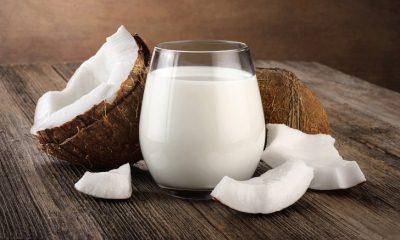 The product is made by mixing crushed coconut and water. Milk is also healthy, but has a neutral taste and smell.
The product is made by mixing crushed coconut and water. Milk is also healthy, but has a neutral taste and smell.
In Russia, coconut milk can only be bought in supermarkets in tetra packs or cans.
Stored in closed packaging for up to 3 years at temperatures up to +30 C. Opened packaging can be stored in the refrigerator for no more than 2 days. Read more about storing coconut milk. Here And here.
Soy
Soy milk is a product of plant origin. The drink is popular among vegetarians and people who replace animal protein with plant protein. In a closed package, the product retains its properties for up to 8 days. Once opened, it should be consumed within 3-4 days. Spoiled milk decomposes, changes smell and structure. This drink is no longer consumed as food.
Pasteurized
Pasteurized milk is produced by heating liquid to destroy harmful microflora. This drink retains its beneficial properties as much as possible, but has the shortest shelf life..
The product is best stored in the refrigerator. A closed package can last the entire shelf life indicated by the manufacturer. Usually this is 7–10 days. An opened pack should be consumed within 2–3 days. Details - here.
UHT
The difference between this drink and a pasteurized one is that it heats up to a boil and cools quickly. It is permissible to keep the closed package at temperatures up to +25 C for up to several months. An opened pack should be kept in the refrigerator and consumed within 3-4 days. Read more Here.
Chest
Human milk has a unique composition and can not spoil for a long time.Depending on the ambient temperature, hygiene of expressing breast milk may not spoil for up to 5–6 hours at room conditions.
Read more here.
Almond
 Another alternative to cow's milk. The drink can be prepared at home or bought ready-made.
Another alternative to cow's milk. The drink can be prepared at home or bought ready-made.
Closed packaging can be stored for up to 12 months at a temperature of +5 degrees. It is better to keep the opened package in the refrigerator for up to 6 days.
It is recommended to drink homemade almond milk 2 days in advance.
Condensed
One of the treats based on cow's milk. The shelf life and storage conditions of the product depend entirely on the technology, packaging used and ambient temperature. In a tin can, the dessert retains its properties for 12 months at temperatures up to +10 degrees and 10 months at temperatures up to +20. Store opened packaging in the refrigerator and preferably consume within 10 days.
Details - here.
Boiled
To keep homemade milk longer, it must be boiled. In this state it will remain fresh for up to 3-4 days.. If boiled milk is placed in the refrigerator, the shelf life will increase to 2 weeks. However, the boiling process destroys not only harmful microflora in milk, but also beneficial ones, depriving it of vitamins and minerals.
Read more Here.
Dry
Powdered milk is a powder. The product is obtained by drying pasteurized cow's milk. Different manufacturers indicate shelf life of up to 6, 8, 12, 24 months.
Read about storing milk powder in this article.
Ghee
This milk has a higher fat content, up to 6%. A special cooking technology gives it a subtle caramel taste and nutty aroma.. Manufacturers recommend storing industrial baked milk in the refrigerator from 0 to +6 degrees.
The requirement applies to closed and open packaging. Depending on the packaging, raw materials, technology, shelf life can be 5, 7, 10, 15 days. Baked milk can be stored in a tetra pack for the longest time, up to 6 months.
Sterilized
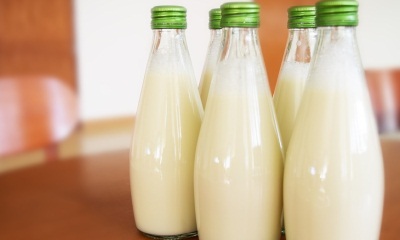 Sterilization is the same boiling process, only under industrial conditions.
Sterilization is the same boiling process, only under industrial conditions.
Due to compliance with technology, hygienic conditions, and tightness of packaging, such milk has a shelf life of up to 6 months at temperatures up to +25 when unopened.
An opened pack should also remain in the refrigerator for up to 3 days. Details - Here.
Homemade
Raw, unprocessed milk has the shortest shelf life. In the open air it can turn sour in 2 hours.
The hotter it is, the faster this will happen. The lower the temperature, the longer the milk will remain fresh. Maximum homemade milk can “last” up to 2 days at a temperature of 10–20. More details can be found here.
What to do with missing milk?
Slightly sour homemade and pasteurized milk acceptable for use in cooking, folk medicine and cosmetology.
A sterilized drink is not suitable for these purposes, since it is not capable of turning sour due to the destruction of all beneficial microflora. This product acquires a bitter taste and a viscous consistency - which means it’s time to throw it away.
Fermented milk can be used in homemade recipes. For example:
- pancakes;
- pancakes;
- omelette;
- cottage cheese;
- cheese;
- barbecue marinade;
- cake;
- pie;
- cookie;
- refreshing drink;
- soup.
Properly fermented milk is valuable for the body. It is useful for those diagnosed with the following conditions:
- rickets;
- lack of calcium;
- constipation;
- atherosclerosis;
- low stomach acidity;
- enzyme deficiency.
Sour milk will also be useful for expectant mothers.
Useful tips
In order not to harm the body with a low-quality product, you need to follow simple rules:
 Always check the expiration date of milk when choosing.
Always check the expiration date of milk when choosing.- Buy as much milk as you need in a few days.
- Always buy fresh product and read the label carefully.
- Purchase farm milk from reputable sellers with appropriate documentation.
- If you like to freeze milk, then you need to store it separately from other products.
- It's best to mark the date and time you froze your milk on the carton to ensure you use the freshest one.
- Do not use milk that is moldy, has a bitter taste or has a foul odor.
Conclusion
Milk is a unique product that benefits children and adults. To enjoy the beneficial properties of the product, it is enough to know the storage features of cow drink and follow precautions.
